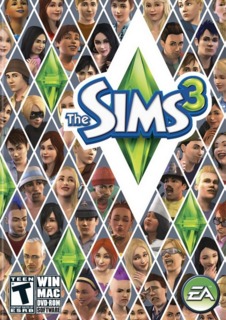The sims world is back with pets
For the first time in the entire franchise, the idea of Pets made me a little wary. This is the third time EA (or Maxis) had a similar idea for the franchise, after releasing The Sims: Unleashed and The Sims 2: Pets years ago. Luckily, EA has added enough that the concept still feels fresh, and it makes for a worthy addition to The Sims 3.
The pets in Pets are basically into two types: low-maintenance pets that you only need to worry about feeding, such as snakes and lizards; and high-maintenance pets that can be trained for tasks. Traditionally, high-maintenance pets were limited to dogs and cats, but EA has added horses to the mix this time.
One of my favorite features of the game is actually the removal of a Sims 2-era feature. Back then, cats and dogs could actually get jobs, and would hop in a carpool on their own to help the family pad its bank account. Even for a game where a werewolf publically making out with a human-plant clone was an everyday occurrence, I thought pet jobs were a little weird. In The Sims 3: Pets, pets do not have strict jobs with specific work hours, but that doesn't mean they can't contribute to the family. Cats and dogs can be trained to hunt, which is their only job skill per se. Cats hunt for other animals, such as low-maintenance pets, while dogs hunt for valuable ores and gems. Unlike previous Pets-like expansions, your pets are fully controllable, so while your humans are away at their jobs, you can personally command your cat or dog to hunt around the town. It's a far less crazy system and allows you the freedom to ignore it if you'd rather just keep the pets for their social benefits.
Horses meanwhile are a nearly game-breaking goldmine if raised correctly. Horses can be trained in running races or equestrian competitions. Your human Sim trainer will also gain skills, such as his ability to ride, and the combined skill of horse and human will affect how you do in races. If you create a new Sim and horse from scratch and do nothing but train, you can probably start pulling in over three grand daily after just an in-game week of training; it would take several weeks to get that much from a conventional job. It's a get-rich-quick scheme that actually works, but it's contained just enough not to unbalance the game.
Strangely, you can adopt a horse-just like dogs and cats-for free at any time. Previous pets-like expansions forced you to spend several hundred Simoleons, shutting it out from first-generation newly made families. This is a bit gamey, but it allows you jump into working with the pets right away, rather than having to wait to establish a family before trying them. You can always pick up strays or attempt to tame wild horses, but doing so takes time and resources new families may not have. It's a time/reward tradeoff: wild animals and strays may come with certain skills and traits already, but they take more effort to adopt.
If profit is the main thing on your mind, horses, dogs, and cats can all be bred and sold, giving you an amount of money relative to their training, skills, and known tricks. Of course, selling them means you can't use their hunting or racing skills for your own profit anymore, so you have the choice in how exactly you want to approach pet ownership. This freedom is what makes The Sims such a fun franchise: there are a number of ways you can play with your pets or use them to get cash, and experimentation is the whole reason The Sims exists.
And speaking of experimentation, the absolute best feature of The Sims 3: Pets is the coat design options. While the game's default breeds are all normal and realistic, you can create pretty much anything you can think of with the easy-to-use tools as long as you understand what the graphical concept of "layering" is. You can even save a custom coat, and later breed it with something else. Like with human Sims, DNA is at play, so your markings and colors may transfer over to the kittens and puppies.
Despite all the control you have over pets and their skills, any given pet's impact in the world is minor. Frankly, this is the way I prefer it: The Sims has always been a life simulator of sorts, and if the pets were able to take the spotlight away from the humans, it would be getting away from the point.
All the animations for all the animals are spot-on, from a kitten sleeping on the floor to a deer loping across your front lawn. You'll need a lot of room on your lot to take advantage of larger animals, but a new neighborhood called Appaloosa Plains features large, roomy lots. New traits, lifetime goals, and objects round out the experience. Sadly, there are very few new clothing options and absolutely nothing new in Build Mode, but much of your time will be spent tinkering with the pets themselves, and you probably won't notice.After The Sims 3: Generations and The Sims Medieval: Pirates & Nobles, I was wondering if EA was out of ideas and had lost its touch with Sims expansions. Thankfully, The Sims 3: Pets puts the series and franchise back on track and continues to make its virtual worlds even more fleshed out. As always, this expansion isn't going to make any non-Sims player a convert, but if you're still enjoying your digital families, this is a good expansion to pick up.

